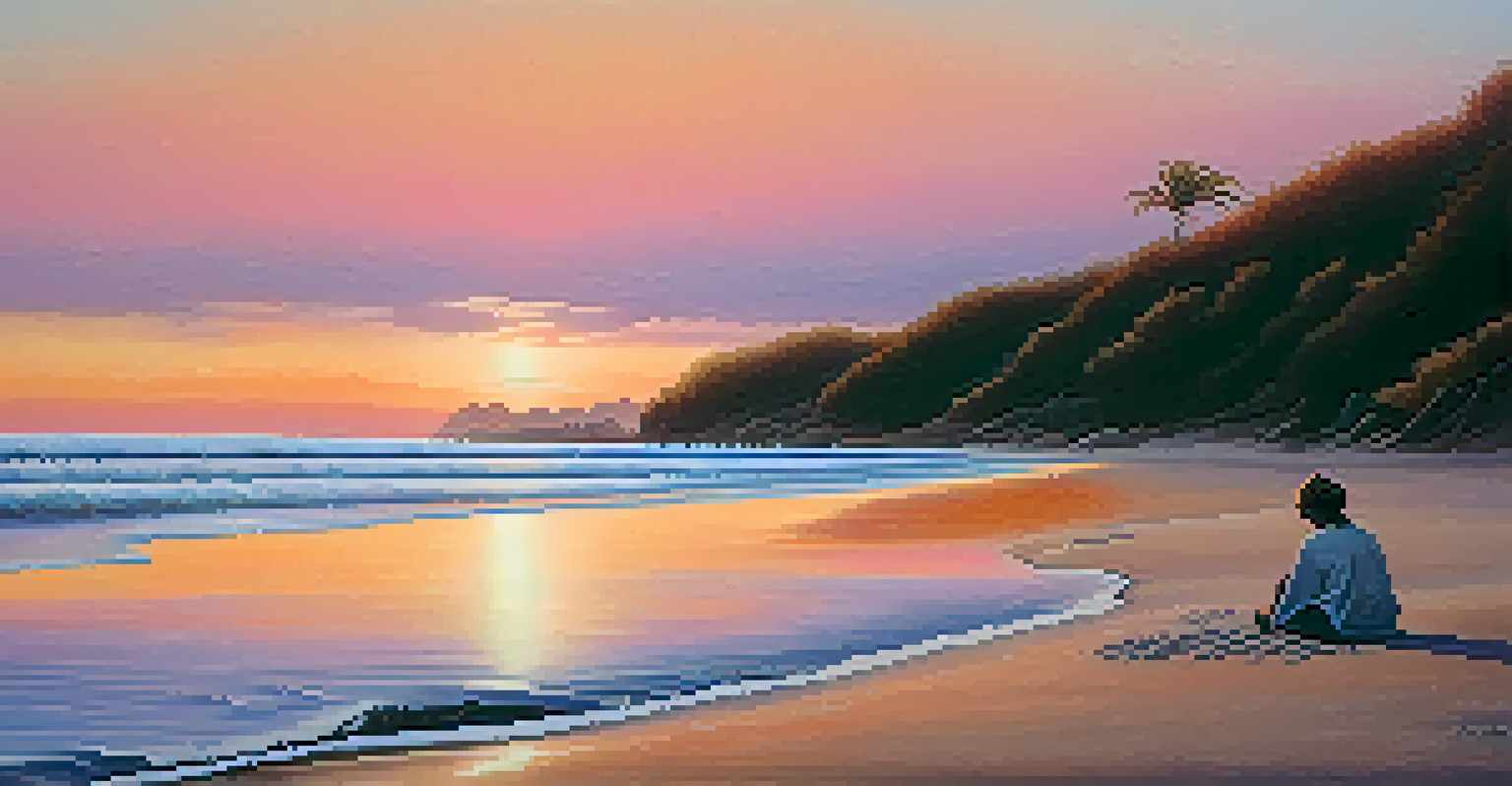Virtual Reality: A New Tool for Better Sleep and Relaxation

Understanding Virtual Reality and Its Benefits
Virtual Reality (VR) immerses users in a computer-generated environment, providing experiences that can feel incredibly real. This technology has evolved beyond gaming, finding its place in various fields, including relaxation and sleep therapy. By creating controlled environments, VR can help reduce stress and anxiety, which are common barriers to restful sleep.
Virtual reality is not just a technology, it's a way to change the way we experience the world and ourselves.
Imagine stepping into a serene forest, with birds chirping and a gentle breeze rustling the leaves. This is the kind of experience VR can offer, transporting you away from daily worries. The ability to engage with calming visuals and sounds can create a psychological buffer, helping users unwind and prepare for sleep.
As more research emerges, the positive impacts of VR on mental health and sleep patterns are becoming clearer. By leveraging this technology, users can create personalized relaxation routines that suit their unique needs, ultimately leading to better sleep quality.
How VR Helps to Reduce Stress and Anxiety
Stress and anxiety are major culprits when it comes to sleep disturbances. VR can be a powerful tool in combating these feelings by providing immersive experiences designed specifically for relaxation. For instance, guided meditations can be enhanced with visual elements that promote tranquility.

Picture yourself floating on a calm ocean, the soft sound of waves lapping at the shore. This virtual escape allows your mind to shift gears, breaking the cycle of stress. Studies have shown that such immersive environments can lower cortisol levels, the hormone associated with stress.
VR Enhances Sleep Quality
Virtual Reality offers immersive experiences that help reduce stress and anxiety, ultimately improving sleep quality.
Moreover, VR can offer users a sense of control over their relaxation environment. By choosing different settings—like a peaceful mountain retreat or a cozy cabin—users can tailor their experiences, which can further reduce feelings of anxiety and promote a sense of well-being.
The Role of Guided Meditations in VR Experiences
Guided meditations are a staple of relaxation techniques, and when combined with VR, they offer an enhanced experience. In a VR setup, users can be taken on a journey that guides them through breathing exercises while surrounded by beautiful landscapes. This immersive aspect can deepen the relaxation experience compared to traditional methods.
The mind is everything. What you think you become.
Imagine being led by a soothing voice as you visualize a peaceful beach, with waves gently crashing nearby. This multi-sensory approach helps anchor the mind, making it easier to let go of stress and distractions. The combination of visuals, sounds, and guidance creates a comprehensive relaxation experience.
As users engage in these guided meditations, they may find it easier to focus and relax, leading to improved sleep outcomes. Research suggests that regular practice of VR meditation can significantly enhance sleep quality over time, making it a valuable addition to anyone’s nighttime routine.
Creating a Personalized VR Relaxation Routine
Personalization is key to making the most out of VR for relaxation and sleep. Users can select environments, sounds, and meditation styles that resonate with them, enhancing their overall experience. This tailored approach ensures that each session feels unique and engaging.
Consider the difference between a generic meditation and one set in a lush, green forest versus a tranquil beach. By allowing users to choose their ideal setting, VR can cater to individual preferences, encouraging consistent use and long-term benefits. The more enjoyable the experience, the more likely users are to incorporate it into their daily routines.
Personalized Relaxation Routines
Users can tailor their VR environments and meditation styles to create unique relaxation routines that resonate with their preferences.
Additionally, many VR platforms offer progress tracking, enabling users to see how their relaxation practices evolve over time. This feature not only motivates users but also provides insight into which environments and techniques are most effective for improving their sleep.
Using VR Technology Before Bedtime
Timing is crucial when it comes to using VR for sleep and relaxation. Engaging with VR experiences shortly before bedtime can effectively signal to your body that it's time to unwind. This can create a soothing transition from the day's activities to a restful state.
Imagine winding down after a hectic day by slipping on your VR headset and immersing yourself in a calming environment. As you engage with this tranquility, your mind begins to settle, making it easier to drift off to sleep afterward. Establishing this routine can help condition your body and mind for better sleep.
However, it’s important to limit VR sessions to a reasonable length, as excessive screen time, even in VR, can lead to overstimulation. Keeping sessions to around 20-30 minutes can strike a balance between relaxation and avoiding the potential pitfalls of screen fatigue.
Combining VR with Other Sleep Techniques
While VR is a powerful tool on its own, combining it with other sleep techniques can amplify its benefits. For example, pairing VR sessions with aromatherapy or soothing teas can create a holistic relaxation experience. This multi-faceted approach addresses various senses, enhancing the overall effectiveness.
Imagine enjoying a warm cup of chamomile tea while immersed in a VR environment that promotes peace and calm. This combination taps into both physical and mental relaxation methods, making it easier to transition to sleep. The synergy of these techniques can provide a more profound sense of relaxation.
Combining VR with Other Techniques
Integrating VR with methods like aromatherapy or light stretching can amplify relaxation and promote better sleep outcomes.
Additionally, incorporating light stretching or yoga before or during VR sessions can further prepare the body for sleep. These gentle movements can help release tension and signal to your body that it's time to wind down.
The Future of VR in Sleep Science
The intersection of sleep science and virtual reality is an exciting area of research. As technology continues to evolve, we can expect to see even more sophisticated VR applications designed to enhance sleep and relaxation. Innovations may include more personalized experiences, adaptive environments, and even AI-driven content that responds to users' needs.
Imagine a future where your VR headset can detect your stress levels and adjust the environment accordingly. This level of personalization could redefine how we approach relaxation and sleep, tailoring experiences in real time to maximize effectiveness.

As we continue to explore the benefits of VR in sleep science, the potential for improved mental health and well-being is significant. With a focus on evidence-based practices, users can expect to see tangible benefits from incorporating VR into their nightly routines.